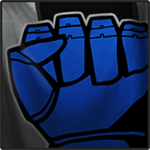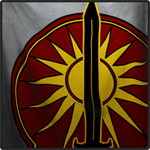Cheers
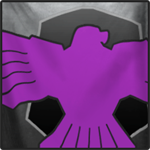
On Cones of Fire Without RNG Nonsense
#201
Posted 25 June 2012 - 06:22 AM
Cheers
#202
Posted 25 June 2012 - 06:45 AM
#204
Posted 25 June 2012 - 01:39 PM
A neat argument while ignoring physics.
Lasers don't need to be moved for slight modification of direction, it can be done with the optical component.
Edited by Tenet, 25 June 2012 - 01:49 PM.
#205
Posted 25 June 2012 - 02:10 PM
#206
Posted 26 June 2012 - 12:01 AM
#207
Posted 25 July 2012 - 12:20 PM
#208
Posted 26 July 2012 - 10:26 AM
 Cavadus, on 18 November 2011 - 12:50 PM, said:
Cavadus, on 18 November 2011 - 12:50 PM, said:
-------
This is one of the largest topics of debate on the forum but what's generally missing from the dicussions are visual aids which quickly and easily demonstrate logical weapon spread concepts.
I have created the (crappy) arts needed to demonstrate a few principles. Let's jump right in.
► 1. Parallel Barrels
This is an issue that is invariably overlooked. Parallel barrels are the barrels of multiple direct fire weapons which cannot converge with one another because they are either mounted in the torso, in which weapons cannot pivot or adjust their aim outside of orienting the entire torso, or are mounted next to one another in the same arm.
Here's a quick demonstration using the arms of a Nova Cat.
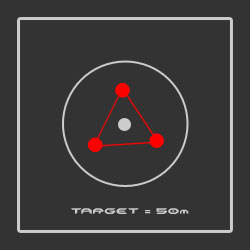
The Nova Cat's left arm is a triple grouping of medium pulse lasers. Since they are all located in the same section the lasers can never converge to hit the exact same point. The barrels are parallel to one another. Parallel things can never intersect which means the lasers can never occupy the same points while traveling.
Firing all medium pulse lasers in a group would leave a hit pattern as illustrated above.
Now, the right arm:
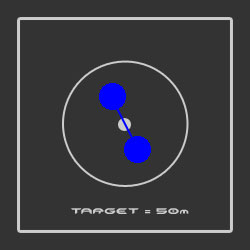
The right arm demonstrates the same concept. The two PPCs are mounted parallel to one another and can never intersect to hit the same point in space.
▼ 1.1 Convergence
Convergence is simply collapsing trajectories so that they overlap onto a target. The Nova Cat has it's weapons in the arms. Arms are very dexterous.
If you look at the two shot groupings above it's not hard to imagine what it would look like if the Nova Cat was targeting a mech for an alpha strike. The two shot groupings would be overlaid onto one another for a composite shot group. It would look like this:
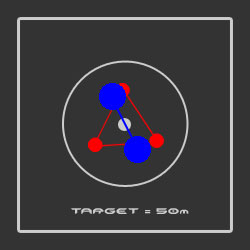
The shot groupings for each individual arm can never change. The space between the points where the weapons strike is the same amount of space between the barrels the weapon's fire is leaving. For instance, if the two PPC barrels in the Nova Cat's right arm are separated by 1 meter then the two PPCs will always strike a target in two locations 1 meter apart from one another and in the same geometric pattern.
The above composite shot grouping demonstrates that arms, because they are independent from one another and dexterous, possess the ability to dynamically converge their weapons' fire trajectories for overlapping fire. This means more weapons can be brought to be bear to hit a smaller portion of a mech.
This leads to an interesting trade off in mech design. Arms can be lost easily but they also provide the most accurate weapon mounts. This is a great unintended balance.
► 2. Torso Weapons
The issue of torso weapons is very complex. Arms can move so they can converge their fire dynamically to match the range of their target.
But so too can torsos move. They can rotate in both directions and pitch themselves up and down. Think of it a bit like a tank's turret. Sure, in a modern turret the gun can be elevated and depressed inside of the turret but that's because the turret itself can't do that.
Torsos can do that.
For this demonstration I'm going to suppose that torso weapons are 100% fixed and not gymbalized. They possess no independent movement from the torso. Aiming a torso weapon means aiming your torso.
Using an AS7-D as my illustration firing the four MLs and AC-20 simultaneously would create a hit pattern something like this:

As you can see the two medium lasers in the center torso and the AC-20 located in the right torso are all parallel to one another and therefore cannot converge. The two arm mounted MLs can converge. But what would this shot grouping actually look like on the poor Zeus?
Something like this:
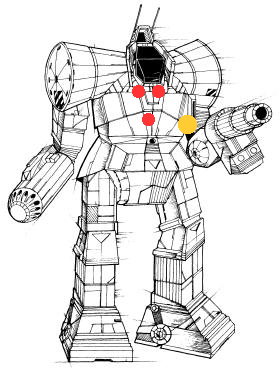
The two upper red dots indicate where the AS7-D's center torso mounted MLs struck the Zeus. The lower single red dot indicates where the two arm-mounted MLs struck the Zeus. Remember, arms can converge to produce overlapping fire patterns at dynamic ranges!
Here's the same image except with a Cone of Fire based meta-reticle:
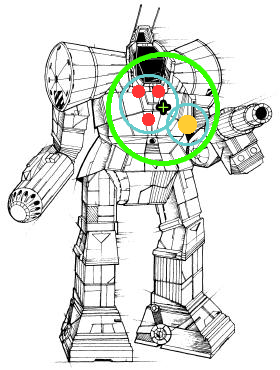
As you can see grouping the MLs and the AC-20 into a single fire group produces a large cone of fire which is inaccurate. The AC-20's ballistic trajectory and origin of fire makes this grouping inaccurate. The two CT mounted MLs are close to one another and mounted centrally on the mech. The arms can converge. Those four MLs combined could provide a relatively accurate and tight cone of fire by themselves.
The AC-20's barrel, or "origin of fire", is located at forearm level but it's off-center on the right side. Since the AC-20 is mounted perpendicular to the torso it's trajectory skews the cone-of-fire reticle to be larger because it's aim cannot be adjusted inwards to better match the reticle's center pip.
But what would the cone-of-fire look like if you subtracted the AC-20?
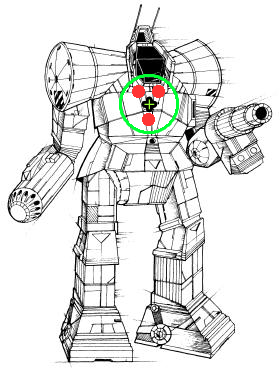
As you can see the cone-of-fire is much smaller because the four ML grouping corresponds much better to a centrally located targeting reticle. You could even go one further with the accuracy and assume that the arms can dynamically converge based on the locations of other weapons in their grouping which means the targeting and tracking system of the AS7-D could tell the arms to move their aim up so that the two arm mounted MLs strike inbetween the two torso mounted MLs. This would create a very accurate and tight shot grouping.
▼ 2.1 Addendum
After some discussion in the thread I'm partially convinced that allowing torso weapons to at least elevate and depress inside of the torso would still allow for the basic premises of this post to function as is. This would of course greatly enhance the accuracy of many weapons as there would now be a "plane of fire" running horizontally across the HUD.
I'm not saying that's how I want torso weapons to operate, I'd still very much prefer that they be 100% static, but allowing elevation and depression of torso mounted weapons would be feasible within the context of this post. I think
► 3. Other Factors Which Influence the Size of the Cone-of-Fire
In addition to the physical locations the weapons are mounted in and the basics of parallel barrels there other factors which can influence where a weapon shot is placed.
▼ 3.1 Movement
Movement is huge. The faster a mech travels the more the arms oscillate to maintain balance during movement. This would create a predictable sway to the path the reticle would travel on for arm and torso mounted weapons.
Using the AS7-D's the four ML weapon group a sway pattern would look something like this:
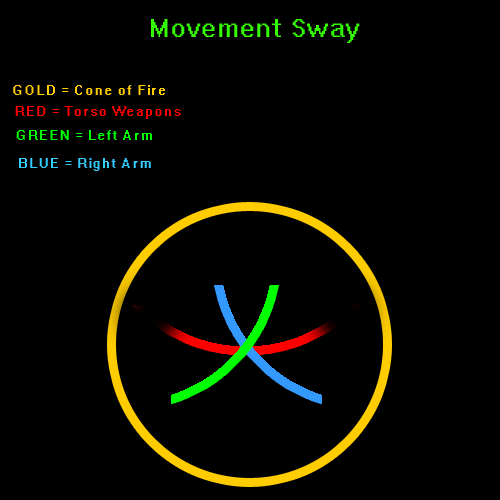
The lines above indicate the paths of travel the weapons mounted on the corresponding location would take during movement. For a practical exercise stand up and lift your forearms so your elbows are bent 90 degrees much like an Atlas' arms.
Now start walking forward and take notice of how your torso twists correspond to which leg you have extended in front of you and the natural movement in your arms that is used to maintain balance.
Using the above sway patterns we can deduce that if the Atlas was running at top speed and you took a snap shot at where the weapons would be aimed on their sway paths when the Atlas' left leg was fully extended forward it would look like this (note that the large DoTs indicate where the weapons inside of the corresponding section would be pointed at inside of the cone-of-fire):
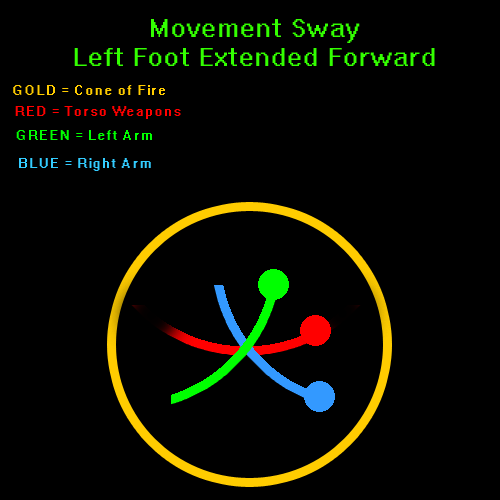
With the left foot fully extended forward at max run speed the torso would be twisted clockwise to some degree so that the right arm comes forward and the left arm is pulled back. This would also move the trajectories of the CT mounted MLs to the right as the torso is twisted that way.
Obviously if the right foot was fully extended the dots would be on the opposite side.
As the speed of the Atlas decreases the length of the sway travel paths would also decrease. If the Atlas was at a dead stop most of the points would be completely center or as near as centered as would be allowed taking parallel barrels into consideration.
▼ 3.2 Standard Devation
Standard deviation would be the innate dispersal of a weapons' fire. Obviously some weapons would logically have larger "standard deviation" than some.
Basically, if you have a weapon 100% zeroed to the HUD's reticle standard deviation would allow for the weapon's fire to offset from that reticle's center pip by X amount of distance. Think of it like the radius of a circle.
This deviation can be measured in either units of distance or in degrees.
For instance, over 500 meters the "standard deviation" of a Large Laser might be something incredibly minute like 50 centimeters. This means that if the LL is perfectly zeroed to its HUD's reticle at 500 meters the laser could strike up to 50 centimeters off the reticle's center pip in any given direction.
Conversely, weapons such as the AC-20 would have a larger "standard deviation" due to the ballistic nature of the weapon.
The deviation I used for the LL above was completely arbitrary.
All that being said the fire spread caused by "standard deviation" would be measured in centimeters at best. In context of the scale of battlemechs the deviation would be minimal if not unnoticeable.
▼ 3.3 Heat & Damage
Other factor's which would obviously influence a non-RNG CoF would be heat and damage. Personally, I don't feel that heat should have influence over standard deviation though damage absolutely should.
Heat should influence the mech's "Targeting & Tracking System" to a small degree but greatly influence the speed and precision of the myomers and actuators used to control and stabilize arms, legs, and the pelvis.
I'd represent heat's influence on weapons' precision by allowing the reticle to "float" a bit due to reduced arm movement and torso stabilization.
► 4. Conclusion
For a semi-realistic and non-RNG based cone-of-fire the only things which really need to be factored into weapons' spread are parallel barrels, torso weapons which are mounted off-center, and the sway paths caused by movement. This creates a predictable weapons spread pattern without introducing any Random Number Generator tomfoolery into the game.
If Piranha included a sensible cone-of-fire system as demonstrated above into MWO along with more detailed and localized damage (imagine breaking each classic BT armor section into three smaller sections each with the full armor value of the original section) one to two shot kills would be a thing of the past.
This also puts the balance of power back towards larger weapons which do more damage as opposed to boating smaller weapons and hoping for the same effect.
This is the single most amazing idea I have read on these forums.
#209
Posted 30 July 2012 - 01:11 PM
#210
Posted 30 July 2012 - 01:50 PM
#211
Posted 30 July 2012 - 08:32 PM
#212
Posted 31 July 2012 - 04:29 AM
#213
Posted 31 July 2012 - 06:03 AM
I believe RNG is used to simulate outside factors that are not necessary present in the game.
1) Wind: Does affect projectiles and missiles.
2) Barrel Heat: When I was learning how to use the M-60, I learned that the hotter the barrel gets, the less accurate the rounds fired get.
3) Terrain: Minor terrain imbalance, such as boulders, pits, cars, etc. are being stepped on constantly, this would affect small distortions in aiming.
Adding each of these elements into the game would increase the processing of the engine and not really provide any value.
#214
Posted 31 July 2012 - 11:16 AM
#215
Posted 31 July 2012 - 11:56 AM
In anycase, this boat already left the port months ago. They've got limited shot grouping based on toros or arm placements.
#216
Posted 08 August 2012 - 02:37 PM
The only thing I wouldn't want is movement sway.
I like the idea for many, many gameplay reasons, the fact that it also makes intuitive sense is just a bonus.
#217
Posted 08 August 2012 - 02:55 PM
#218
Posted 08 August 2012 - 03:00 PM
#219
Posted 08 August 2012 - 06:11 PM
If you want to talk about heat affecting weapon accuracy and other things at that level of realistic detail, you certainly don't want to be talking about them in a game involving 100 ton walking tanks.
#220
Posted 08 August 2012 - 08:44 PM
One common failure devs have in maintaining balance is due thier lack of adherence to natural laws, the give and takes, the losses in one area to gain in another, deminsihing returns, loss of effiency with an increase in output, etc, etc.
The failure to adgere to these basic natural principlies is what allows relationships, balance, models, etc to spiral out of control to allow for broekn systems and exploits.
So yeah, we can have 100 ton mechs, but we cant have weapons systems, models, relationships outside the stretch of the imagination for the viability of our avatars, to ignore these natural laws.
The beuaty about natural laws, there adherence in game provides intuitive understanding by the player of the various relationships within the game's various models/mechanics. That means, the complexity of the model can exist, without needing to require the players to be involved regarding the "hows", just code it in, and in the player's eyes, the game world just clicks and makes sense.
Edited by CocoaJin, 08 August 2012 - 08:47 PM.
1 user(s) are reading this topic
0 members, 1 guests, 0 anonymous users







